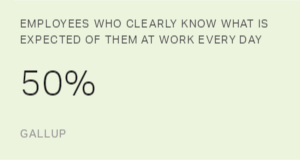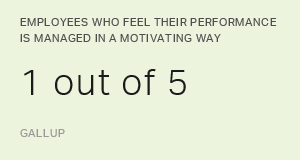Story Highlights
- Don't overlook the organizational costs of employee burnout
- Burnout is strongly influenced by how employees are managed
- Burnout is preventable when you focus on the right factors
In this three-part series, we examine 15 workplace factors that correlate highly with employee burnout. First, we discuss the top five causes of burnout, then we look at the next five factors to consider from a management perspective. In the final article, we explore the last five factors, which focus on what organizations can do to prevent burnout.
Organizations are facing an employee burnout crisis. A recent Gallup study of nearly 7,500 full-time employees found that 23% of employees reported feeling burned out at work very often or always, while an additional 44% reported feeling burned out sometimes. That means about two-thirds of full-time workers experience burnout on the job.
Although burnout has become "just part of the job" for many workers, the hard organizational cost of burnout is substantial: Burned-out employees are 63% more likely to take a sick day and 2.6 times as likely to be actively seeking a different job. And even if they stay, they typically have 13% lower confidence in their performance and are half as likely to discuss how to approach performance goals with their manager.
In short, employee burnout can trigger a downward spiral in individual and organizational performance.
And not surprisingly, the effects of burnout don't stop at the office door. Employees who consistently experience high levels of burnout are two times more likely to strongly agree that the amount of time their job takes makes it difficult to fulfill their family responsibilities. Even scarier, burned-out employees are 23% more likely to visit the emergency room.
| 63% more likely to take a sick day | |||||||||||||||||||||||||||||||||||||||||||||||||||||||||||||||||||||||||||||||||||||||||||||||||||
| Half as likely to discuss how to approach performance goals with their manager | |||||||||||||||||||||||||||||||||||||||||||||||||||||||||||||||||||||||||||||||||||||||||||||||||||
| 23% more likely to visit the emergency room | |||||||||||||||||||||||||||||||||||||||||||||||||||||||||||||||||||||||||||||||||||||||||||||||||||
| 2.6 times as likely to leave their current employer | |||||||||||||||||||||||||||||||||||||||||||||||||||||||||||||||||||||||||||||||||||||||||||||||||||
| 13% less confident in their performance | |||||||||||||||||||||||||||||||||||||||||||||||||||||||||||||||||||||||||||||||||||||||||||||||||||
| Gallup | |||||||||||||||||||||||||||||||||||||||||||||||||||||||||||||||||||||||||||||||||||||||||||||||||||
This puts organizational leaders who care about their employees in a tough situation: They don't want their employees to get burned out, but they also need to inspire higher productivity and performance.
In most situations, however, this is a false dichotomy. The main factors that cause employee burnout have less to do with expectations for hard work and high performance -- and more to do with how someone is managed.
5 Factors Leaders Should Focus on to Reduce Burnout
These five factors were most highly correlated with burnout in our study:
1. Unfair treatment at work
When employees strongly agree that they are often treated unfairly at work, they are 2.3 times more likely to experience a high level of burnout. Unfair treatment can include everything from bias, favoritism and mistreatment by a coworker to unfair compensation or corporate policies.
When employees do not trust their manager, teammates or executive leadership, it breaks the psychological bond that makes work meaningful.
2. Unmanageable workload
In sports psychology, coaches use the term "mental quicksand" to describe how moments of poor performance can cause athletes to feel overwhelmed. This leads to further poor performance and damage to their confidence that continues to drag them down. High-performing employees can quickly shift from optimistic to hopeless as they drown in an unmanageable workload.
When their workload is out of control, employees look to their managers to be their advocates for what they can and can't accomplish and for finding others to help them.
3. Lack of role clarity
According to our recent State of the American Workplace report, only 60% of workers can strongly agree that they know what is expected of them at work. When accountability and expectations are moving targets, employees can become exhausted just trying to figure out what people want from them.
The best managers discuss responsibilities and performance goals with their employees and collaborate with them to ensure that expectations are clear and aligned with those goals.
4. Lack of communication and support from manager
Manager support and frequent communication provide a psychological buffer, so employees know that even if something goes wrong, their manager has their back. Employees who strongly agree that they feel supported by their manager are about 70% less likely to experience burnout on a regular basis.
In contrast, a negligent or confrontational manager leaves employees feeling uninformed, alone and defensive.
5. Unreasonable time pressure
When employees say they often or always have enough time to do all of their work, they are 70% less likely to experience high burnout. Granted, there are some professions that will always have extreme time constraints -- like paramedics or firefighters. Not surprisingly, people in these roles are at high risk for burnout. In other fields, however, time constraints are often imposed by people who do not know how long it takes to deliver quality work or great customer service.
Unreasonable deadlines and pressure can create a snowball effect -- when employees miss one overly aggressive deadline, they fall behind on the next thing they are scheduled to do.
Burnout is not inevitable.
You can prevent -- and reverse -- burnout by changing how you manage and lead your employees. If you don't address the true causes of employee burnout in your organization, you won't have a workplace environment that empowers employees to feel and perform their best.
And when employees are running low on high-performance fuel, so are your organization's decision-making, customer service, quality control and innovation engines.
If you are a leader with limited resources to spend on reducing burnout, focus on the five factors above to yield your best return on investment. And don't miss the next article, which will discuss the next five factors that predict burnout among your employees, with additional insights on the role managers play in reducing burnout.
Take a closer look at what Gallup recommends for better management and reducing burnout:
- Download our position paper, Re-Engineering Performance Management, to find out how to improve your performance management systems.
- Discover the best ways to prevent employee burnout.
- Discover how to optimize your workplace by creating a culture of well-being for all your employees.


